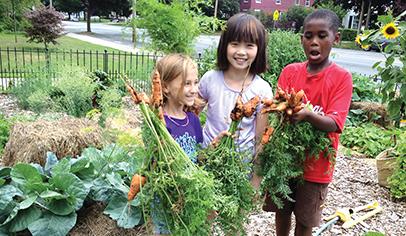Student Gardeners Enjoy Fruits of Their Labor

At a school garden club in Saratoga Springs, N.Y., a parent volunteer finds that students are fans of fruits and veggies when they help with the planting.
At Lake Avenue Elementary in Saratoga Springs, N.Y., the garden club members don’t just grow an amazing assortment of fruits and vegetables; they can also whip up delightful salads, pasta and broccoli dishes, and even an occasional sauerkraut and borscht.
“The point is to teach [the students] where their food comes from and to get them to like both cooking and eating—and to be brave about it,” says Carol Maxwell, a parent volunteer who founded the Lake Avenue Garden Project.
Maxwell has shepherded this group since 2008. That first year, the group got a late start, so they quickly dug a small garden in a schoolyard spot that turned out to be too shady. Production was less than stellar, but each week Maxwell and the kids would troop over to her house to cook whatever could be harvested.
During that first year, Maxwell had opened the club to all students. But she found that managing a group with children as young as 5 and as old as 11 didn’t work well. To keep everyone safe, she relied on very simple recipes, and some older kids grew bored.
So she made some tweaks. The club is now open to students in 3rd through 5th grades. This past year, she had a happily engaged group of 25 students. The garden has been moved to a sunny location at the school. It measures 30 feet by 20 feet and produces up to 30 different kinds of fruits and vegetables.
Last year, the group did its cooking in the Lake Avenue Elementary teachers lounge, a small room with one stovetop. This year, they will be moving into an unused classroom that will take them to a whole new level. Dubbed the “food lab,” it has four portable cooking ranges, a refrigerator, tables, chairs, shelving, and windows with large sills that are perfect for growing seedlings. The members will be able to explore more aspects of cooking, plus they are planning to work with other clubs and help at class events, too.
“With the food lab as our new home, we want to expand food and nutrition education to a wider audience,” Maxwell says. “We have several before-school clubs and language clubs and the teachers love being able to incorporate culture into lessons. So they can now use our food lab to add cooking.”
Maxwell says her goal for the Lake Avenue Garden Project is to help children become intentional about food. She encourages her club members to keep journals throughout the year so they can reflect on what they enjoyed about the full life cycle of planting, harvesting, cooking, and eating.
For this school year, Maxwell says she is hoping to focus more on cooking skills. “I want them to learn how to use knives and other tools properly,” she says. “I want to focus not so much on creating recipes but on cooking techniques, like sautéing or steaming, so they can learn to freestyle.”
And sometimes, it’s as freestyle as you can get. During some summer weeks, she adds, “we just sit outside, hose off some veggies, and eat them raw.”
Lake Avenue Elementary PTA
Saratoga Springs, N.Y.
470 students, grades K-5
Cultivating a Garden Club
Fall
- Promote your new club!
- Welcome students (and their parents) and explain how the club works.
- Decide on garden location and size.
- Dig and “open up” the garden’s soil. Cover with layer of leaves for the winter.
Winter
- Sketch out your garden plan (what plants will go where.) Order seeds and seedlings.
- Plan a small spring fundraiser to cover costs of purchasing seeds and plants, or other expenses.
Spring
- Start planting “salad crops” from seed in early spring. Vegetables like lettuce, cilantro, and arugula are “almost indestructible,” says Maxwell, noting that they can go in the ground by early April, even in the Northeast.
- Run a small fundraiser if needed. Maxwell’s group does a plant sale around Memorial Day.
- Start seedlings indoors for tomatoes and other summer crops.
- Add compost to garden soil, if needed.
- Plant all summer crops before the end of school.
- Create a watering schedule for the summer, asking families to take charge for chunks of time.
Summer
- Keep it casual. Visit the garden; invite families to stop by to see its progress.
- Put together a preliminary schedule for harvesting and cooking, based on when you expect vegetables and fruits to be ripe.
Fall
- When school begins, restart the club. Hold a weekly meeting during which you begin harvesting crops and cooking.
- Encourage the kids to keep a journal so they can learn what parts of the gardening process they enjoyed and what recipes they enjoyed most.
- Harvest and cook through late fall. Maxwell reports that vegetables like kale continue to grow even when snow is on the ground!
Oh, and remember to:
- Make sure that you get buy-in from the principal and that he’s comfortable with the scope of the project.
- Keep it small at first so the group gets a chance to develop its green thumb.
- Increase the size you think you need by at least 30 percent when sketching out your garden plot. You need wide walkways between plant rows so kids can easily work in the garden.
- Select moderate amounts of several types of vegetables when choosing what to plant. This way, students will experience many different flavors and not get overloaded by any one variety.






















